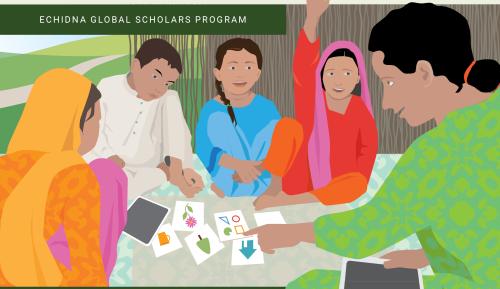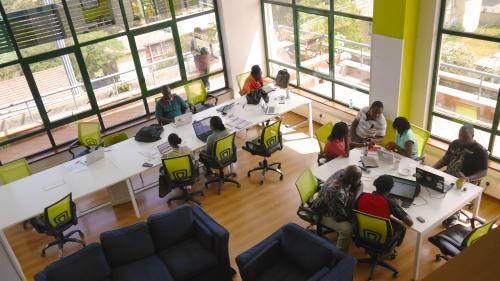Every year, the UN marks International Women’s Day by identifying a critical challenge impacting women and girls and advocating new policy tackling the issue. As the world continues to grapple with the implications of AI chatbots and the strong link among social media, misinformation, and democracy, this year’s theme “DigitALL: Innovation and technology for gender equality” examines the link between digital technologies and gender.
At the forefront of building an inclusive digital world for girls and women are several Echidna Global Scholars working on gender equality in and through education across the Global South. Their policy research and praxis addresses pressing issues such as barriers to STEM education in rural Bangladesh, the economic potential of digital mentoring in India, and the gender divide in digital technology courses and careers in Kenya.
For this year’s International Women’s Day, we asked these three alumni scholars to share their reflections on the digital gender divide and the important work that lies ahead in imagining a more digitally inclusive world.
 Nasrin Siddiqa, 2019 Echidna Global Scholar; Executive Director – Education & Cultural Society, Bangladesh
Nasrin Siddiqa, 2019 Echidna Global Scholar; Executive Director – Education & Cultural Society, Bangladesh
It is time to think whether innovations and technology will be utilized to ensure equality and rights to accessing education and economic opportunities for women or to make women more vulnerable. Considering the theme of this year’s International Women’s Day, we need to make a policy of digitalization in empowering women and ensuring girls pursue their interests in STEM and break down gender barriers.
We need to ensure that emerging technologies and artificial intelligence will be used to improve gender equality significantly by creating new opportunities and removing barriers for women and girls, rather than leaving millions of poor women workers unemployed. In Bangladesh, women face challenges to accessing education and economic opportunities. By using technology to provide educational resources, training opportunities, and access to information, we can empower women.
The world needs to simultaneously rescue women with immediate measures, and on the other hand, strengthen the next generation to deal with super-fast technology and digitalization. Researchers can play a vital role in informing need-based policy and understanding its impact. Digitalization should be human, and especially women-friendly. It would make the lives of women more comfortable and easier, rather than making them insecure. It would contribute to girls’ education, stop violence and trafficking, helping make girls and women aware of places and people, ensure digital marketing and entrepreneurship, provide health care information and services to women in rural areas and free educational resources and training, and enable the development of new skills and access to new economic opportunities for underserved women.
We can create a brighter, more equitable future for women around the world.
 Arundhuti Gupta , 2021 Echidna Global Scholar; Founder Trustee and CEO – Mentor Together
Arundhuti Gupta , 2021 Echidna Global Scholar; Founder Trustee and CEO – Mentor Together
We stand at an important juncture today where technology can become either one of our most consequential allies—if channeled effectively in our fight for gender equality—or if left to be shaped by the existing structures of society, yet another platform for the exclusion and disempowerment of women.
One of the most positive trends of the last four years had been that the gender gap in the use of mobile internet had been reducing. Worryingly, the rate of adoption by women has seemingly stalled in 2021. My nonprofit organization, Mentor Together, runs a large career mentoring program based out of India that thousands of young women in universities access via their mobile phones. The increasing access to phones presented an avenue to counter the restrictions placed on the movement and freedom of young women and help them virtually access personalized career mentorship from inspiring role models across the country. Without concerted efforts to increase mobile phone access, women will lose out on even this avenue of learning.
The second opportunity that strikes me as critical for India is that the design of digital communities should very intentionally bring in ways to champion gender- transformative social norms. I found through my research that even well meaning, large communities of mentors can end up becoming limited champions because their messages never reach the people who need convincing (in this case the families and communities of our mentees). It is worrying that so much of the digital discourse in India displays the same negative gender norms with even quicker dissemination. The most powerful role of technology we have to intentionally design is positive human connection spreading in more virtuous cycles.
 Anthony Luvanda, 2022 Echidna Global Scholar; Senior Lecturer, Information Technology department, Defence Forces Technical College – National Defence University-Kenya; Co-Founder & Executive Director – Magharibi Innovation Hub
Anthony Luvanda, 2022 Echidna Global Scholar; Senior Lecturer, Information Technology department, Defence Forces Technical College – National Defence University-Kenya; Co-Founder & Executive Director – Magharibi Innovation Hub
Digital technology has a role to play in bridging the various gender gaps within the workplace, yet we need to set in motion various interventions aimed at placing more women in the digital technology workspace.
The gender gap in the digital technology workforce begins early, as very few girls take up digital technology-related courses at the tertiary level of education. Girls from the lowest levels of education are subjected to cumulative disadvantages that reduce their chances of ending up in a digital technology career.
My research on the subject reveals that one of the best approaches to having more women in the digital technology workspace revolves around creating interventions for mitigating the cumulative disadvantages that lead to the exclusion of women from digital technologies careers. Such interventions may include but must not be confined to: improving institutional digital technology infrastructure at all levels of education; enhancing the training of digital technology personnel within all levels of education; building girls’ interest in digital technology-related courses from the earliest years; increasing digital technology advocacy and awareness among girls; and enhancing vocational counseling on digital technology careers.
The Brookings Institution is committed to quality, independence, and impact.
We are supported by a diverse array of funders. In line with our values and policies, each Brookings publication represents the sole views of its author(s).












Commentary
Innovation and technology for gender equality: Echidna Global Scholars taking action
March 8, 2023